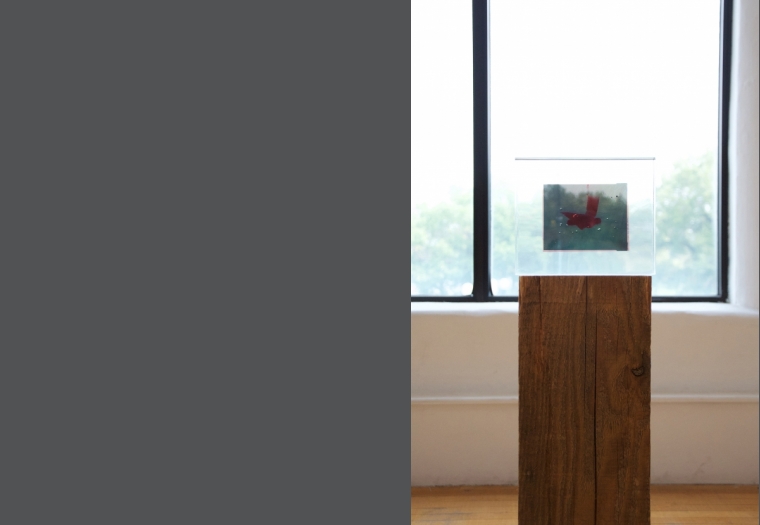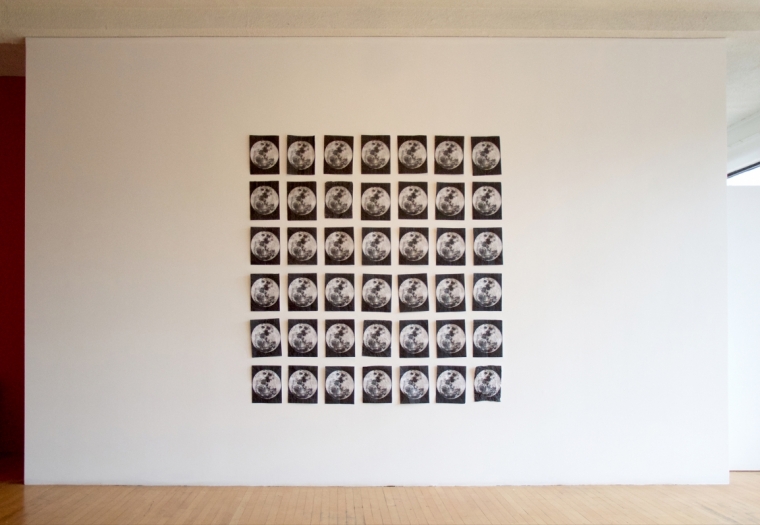LIGHT OF OTHER DAYS
Light of Other Days is an evolving collection of work exploring the effects of technology on our relationship to the natural landscape. Many of the works are photographically based, emulating stereotypical nature photography, but transformed through sculptural and digital interventions. The artists deal with the prints as objects in their own right, using lighting, mirrors, drapery, and various sculptural materials, among other methods, to disrupt the illusionistic qualities of the nature photograph. This forces the viewer to realize their psychic removal and remote proximity to the idealized landscape.
Robert Collier Beam and Brooks Dierdorff describe their ongoing collaboration via questions posed through the lens of landscape: What is the mirror effect between landscape and technology, and how does each inform our understanding of the natural world and ourselves?What are the consequences of experiencing the natural world through fixed and repeatable representations? Exploring cultural, scientific, and personal themes within various landscapes around the world, we continually challenge our own understanding and perceptions of nature. What are the consequences of experiencing nature through images and fixed representations?
Brooks Dierdorff is an interdisciplinary artist, working in photography, video, sculpture and performance. He received his BA from the University of California, San Diego in 2007, and his MFA from the University of Oregon in 2012. He currently holds the position of Visiting Assistant Professor of Art at Southern Oregon University in Ashland, Oregon.
Robert Collier Beam is an interdisciplinary artist working in photography, installations and drawing. Robert received MFA in Photography from the University of Oregon and BFA in Studio Arts from the University of North Texas. Finding inspiration from the land, scientific exploration, and natural phenomena, Robert’s work explores the evolution of perception centered on the spaces we create and challenge. Creating object based and image based works which call attention to our inherent need to explore and see further. Robert currently resides in Dallas, Texas and is available for commission and collaborative projects.
Dominion over nature is gospel and thereby guaranteed, even though this promise we blindly believe or addictively pursue comes up against the fact that available resources are much more finite. And we know better. The vast majority of us believe in impending ecological upheaval, yet taking to the streets en masse is superseded by a financial need to clog roads in commutes powered by fossil fuels. Pragmatic solutions are presented, yet we seem to lack a willful consensus to institute substantial changes to forestall the inevitable demise of the world as we would prefer it (as opposed to how we know it). And by “we” I mean the empowered and the compromised, any kind of believer or denier alike.
To wit: Scientists in genomic research are working to reintroduce the passenger pigeon into the wild by 2027. On August 2 of that same year, during a partial solar eclipse, some expect Jesus Christ to once again stand upon the Mount of Olives, and in doing so usher in the final stages of the End Times. Hope against hope.
In their Light of Other Days, Robert Collier Beam and Brooks Dierdorff float upon the resonant energy created by these contrary forces, and from this place they are able to draw what we cannot see from within what we know. What results is an empiricism based on potentiality instead of dominant positivistic models.
One cannot help but impose an environmentalism upon Beam’s and Dierdorff’s art, yet the artists’ own observations made manifest are not enough for a mobilization, largely because the viewing of the work is often somehow thwarted. The old truism, “An object not art without the viewer’s volition,” becomes problematized: We clearly can see this is art, but part of the artist’s process also seems to involve its undoing. The artwork folds back on itself —sometimes with a slight twist, and other times in full reversal— to disrupt the equilibrium of our expectations: Beam’s images of the moon waver and fracture from the unlikelihood of ever arriving at the hoped-for destination; and, Dierdorff’s negative of a carrier pigeon depends on presentation in order to get it’s message to the viewer. Far from self-defeating, this offsetting allows the focus of attention to shift to the viewing as more real than anything that led to the object’s creation, and for that matter, ultimately more present than the object itself.
It is our presence as audience and our subsequent attempt to resolve any minor delirium created by the object that spurs us to create our own meaning. Art, when done right, provides the awareness that one’s habit of perception falls short in the face of a more whole experience, some of which we cannot know. (After all, everything we know and believe has within it an aspect that is askance.) By creating unease within the otherwise familiar, Beam and Dierdorff provoke the viewer into becoming less sure yet hyper-aware in their viewing, and by extension, hopefully, more accountable elsewhere.
–Patrick Collier
TRAP\DOOR ARTIST RUN CENTRE \ ANNUAL EXHIBITION WITH THANKS TO JOHN SAVILL AND THE TRIANON GALLERY







